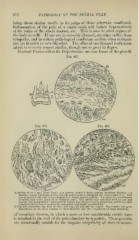Page 862 - My FlipBook
P. 862
872 PATHOLOGY OF THE DENTAL PULP.
bring about similar results in the pulps of those otherwise unaffected.
Inflammation of the pulp of a single tooth will induce hypersesthesia
of the pulps of the whole denture, etc. This is seen in other organs of
the body as well. If one eye is seriously diseased, the other suffers from
sympathy, and in certain pathological conditions oculists often extirpate
one eye in order to save the other. The effect of one diseased tooth upon
others is in every respect similar, though not so great in degree.
Dentinal Tumors within the Pulp-chamber are rare forms of the growth
Fig. 467.
^, Section of an Upper Molar Tooth: a, a carious cavity; h, fairl)- regular secondary dentine; r, a
dentinal tumor which has grown into the pulp-chaniber, occupying the greater part ol' it. This
was attached to the wall of the chamber by a rather narrow pedicle. The structure is extremely
irregular, and varies much iu its different parts. The section was saturated witli balsam and
ground thin and polished ; afterward the balsam was dissolved out in turpentine, and it was then
soaked in chloroform to remove tlie turpentine, and finally mounted dry.
.B(Fig. 4(;7) iiiircsents one field of view, and I'igs. 468 and 469 two otliers. The tubules are quite
remarlvable for the large number of their branches and the irregularity of their direction.
of secondary dentine, in which a more or less considerable calcific mass
is attached to the wall of the pulp-chamber by a pedicle. These growths
are occasionally notable for the singular irregularity of their structure.


